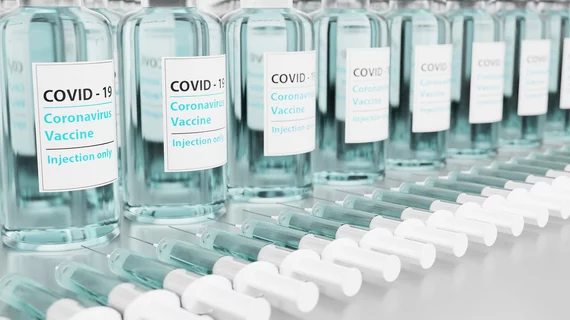Radiologists must educate themselves about the potential imaging findings stemming from COVID-19 vaccinations, experts charged on Wednesday.
Imaging can serve as a “valuable asset” in this process, providing crucial data on these drugs. This could include everything from vaccine efficiency in the research setting to understanding the various confusing radiologic patterns that may pose diagnostic challenges for physicians, according to an editorial in Clinical Imaging.
“Radiologists need to be aware of vaccines’ potential implications on imaging studies,” Ali Gholamrezanezhad, MD, with the Department of Diagnostic Radiology at the University of Southern California’s Keck School of Medicine, and colleagues wrote Jan. 27. “Being familiar with these findings and pitfalls will help radiologists prepare for possible imaging challenges in immunized patients in the future.”
Gholamrezanezhad et al. gave four examples in which radiology could prove pivotal during the vaccine rollout:
- Molecular imaging will enable physicians to track immune cell dynamics in the host body, holding “valuable research attention” in the vaccination field.
- Serial CT could prove as a “great indicator” of vaccine efficiency in the research realm, particularly as immunized individuals may be protected against the appearance of pulmonary ground glass opacities.
- FDG-PET may also help observe lymph node activation following vaccination, offering a useful means of gauging the immune response and vaccine efficacy.
- MRI or ultrasonography have been used frequently in the past to evaluate the local reaction at the injection site and detect any vaccine-induced inflammatory lesions. This response could potentially mimic various confusing imaging patterns, the editorialists noted. And taking vaccination history before imaging acquisition “is of great importance to avoid unnecessary therapy intervention secondary to reactive and false positive findings.”
“The clinical value of current imaging technology on the study of vaccine efficacy is a pertinent field of concern and, as demonstrated, a valuable asset for diagnostic medicine,” Gholamrezanezhad and colleagues concluded.
You can check out the rest of the editorial from Clinical Imaging here. For further reading, the journal also published this study on imaging features from recipients of the vaccine, and RSNA’s Radiology shared this case study on the imaging of a vaccinated patient using FDG-PET/CT.

